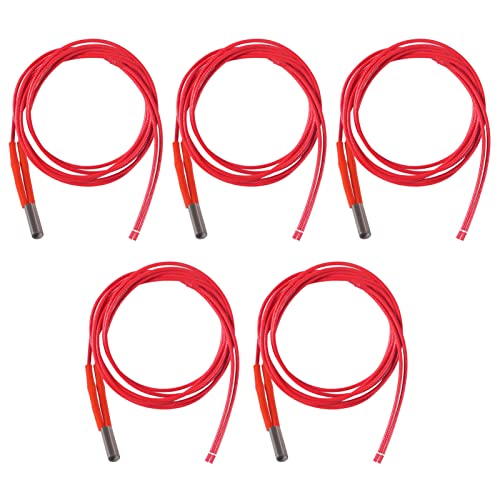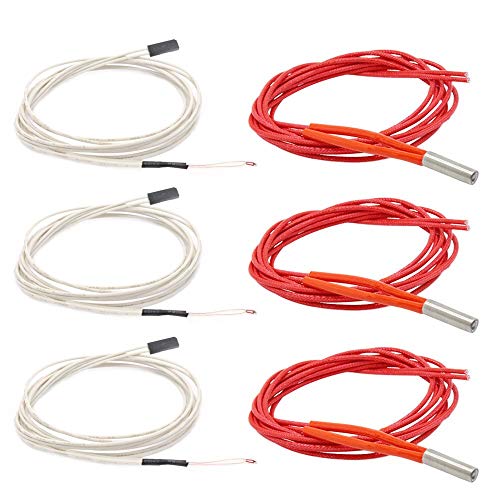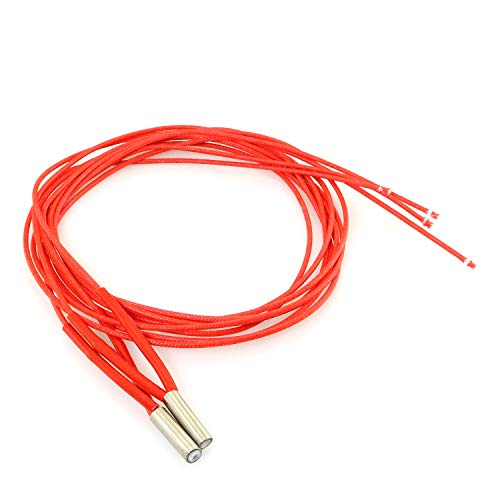Miniature cartridge heaters provide concentrated, fast heating in compact spaces for 3D printers, lab equipment, and small tooling. The table below summarizes five compact cartridge heaters with small diameters and features relevant to miniature heating tasks.
| Product | Diameter | Power / Voltage | Notable Feature |
|---|---|---|---|
| DIANN 12V 40W Heater Cartridge | 6mm | 12V / 40W | 1m high-temp wire, 304 stainless steel |
| ACEIRMC 24V 40W Ceramic Cartridge Heater | 6mm | 24V / 40W | 3950 100K NTC thermistor, PTFE wiring |
| RLECS 6x20mm Cartridge Heater (2pcs) | 6mm | 12V / 40W | Stainless steel, two-piece pack |
| ProTechTrader 12V 40W Ceramic Cartridge Heater | 6.35mm (1/4″) | 12V / 40W | MK10 OEM fit, 1m wire |
| POLISI3D 12V 60W High Temperature Cartridge | 6mm | 12V / 60W | Closed stainless sleeve, 1m cable |
Content Navigation
- DIANN 12V 40W Heater Cartridge 6x20mm
- ACEIRMC 24V 40W Ceramic Cartridge Heater 6x20mm
- RLECS 2pcs 6x20mm Cartridge Heater 12V 40W
- ProTechTrader 12V 40W 1/4-In Ceramic Cartridge Heater
- POLISI3D 12V 60W High Temperature Cartridge Heater 6x20mm
- Buying Guide: Choosing A Miniature Cartridge Heater
- Diameter And Fit
- Power, Voltage, And Watt Density
- Length And Insertion Depth
- Material And Sleeve Construction
- Temperature Sensing And Control
- Lead Wires And Insulation
- Package And Quantity Considerations
- Application-Specific Perspectives
- Safety, Thermal Limits, And Controller Compatibility
- Comparative Summary
DIANN 12V 40W Heater Cartridge 6x20mm

This DIANN cartridge heater is a compact 6mm diameter, 20mm length heating element rated at 12V and 40W. The sleeve is made from 304 stainless steel and includes 1 meter of high-temperature resistant pre-wired cable for straightforward installation. The small form factor suits MK-style extruders and other tight-bore applications.
Features listed: 12V 40W power, 6mm diameter, 20mm length, 304 stainless steel construction, and 1m pre-wired lead. The product’s wiring and material specification indicate suitability for frequent thermal cycling in small devices when used within rated limits.
ACEIRMC 24V 40W Ceramic Cartridge Heater 6x20mm

The ACEIRMC unit is a 24V 40W ceramic cartridge heater with a 6mm diameter and 20mm length. It includes a 3950 100K NTC thermistor and 1 meter PTFE-insulated wiring with a female pin head, simplifying temperature sensing and controller integration on 3D printers or small hotbed setups.
Call 888-896-7031 for Free Local HVAC Quotes – Compare and Save Today!
Features listed: 24V/40W, ceramic heater, 6mm diameter, 1m PTFE wire, glass bead sealing, and supplied thermistor. The integrated thermistor makes this option useful where temperature feedback and closed-loop control are required.
RLECS 2pcs 6x20mm Cartridge Heater 12V 40W

RLECS supplies a two-piece set of 6mm x 20mm cartridge heaters rated at 12V and 40W. Construction is stainless steel with 1m wiring supplied. Two units are convenient for spare replacement or dual-extruder setups where matched heating elements simplify thermal tuning.
Features listed: 6mm diameter, 20mm head length, stainless steel material, and packaged as 2 pieces. The twin pack can reduce downtime by offering a direct replacement on hand for miniature heater bores.
ProTechTrader 12V 40W 1/4-In Ceramic Cartridge Heater

This ProTechTrader cartridge is a 12V 40W ceramic heater with a 1/4-inch (6.35mm) diameter and 1m wire. It is described as an OEM-style fit for MK10 extruders and common FDM printers, compatible with many consumer printer heater block bores.
Call 888-896-7031 for Free Local HVAC Quotes – Compare and Save Today!
Features listed: 12V/40W, 6.35mm diameter, 1m wire, and designed for MK10 compatibility. The near-1/4-inch diameter may fit heater blocks specified for that size without modification.
POLISI3D 12V 60W High Temperature Cartridge Heater 6x20mm

The POLISI3D cartridge heater is a higher-power miniature element rated 12V at 60W with an 6mm by 20mm form factor and a 1m cable. The product emphasizes a closed stainless steel sleeve and durable white high-temperature cable for improved longevity under repeated cycles.
Features listed: 12V/60W, OD6 x 20mm, 1m cable, closed stainless sleeve, and high-quality white cable. The increased watt density supports faster heat-up times but requires attention to controller capability and thermal mass of the application.
Buying Guide: Choosing A Miniature Cartridge Heater
Selecting the right miniature cartridge heater requires assessing diameter, watt density, voltage, length, sensing, and connection type. Below are practical considerations and comparison perspectives to help match a heater to your application.
Diameter And Fit
Measure the heater bore or block hole precisely. Common miniature diameters include 6mm, 6.35mm (1/4 inch), and 8mm. A tight press fit improves thermal transfer; too loose a fit raises thermal resistance and reduces performance.
Power, Voltage, And Watt Density
Match heater power and voltage to your power supply and controller. Higher wattage in the same diameter increases watt density, delivering faster heat-up but raising risk of overheating the sleeve or nearby parts. Ensure the controller and wiring handle rated current.
Length And Insertion Depth
Cartridge heaters come in short heads (e.g., 20mm) and longer rods (e.g., 100mm). Choose a length that provides adequate contact surface while avoiding protrusion that may cause uneven heating.
Material And Sleeve Construction
Stainless steel sleeves are common for corrosion resistance and mechanical strength. Look for descriptions like 304 stainless or a closed stainless sleeve for improved durability under thermal cycles.
Temperature Sensing And Control
Heaters with integrated thermistors or provisions for external sensors allow closed-loop control. If precise temperature regulation is required, choose units with a compatible NTC thermistor or ensure a sensor can be placed close to the heating zone.
Lead Wires And Insulation
Lead length and insulation type (e.g., PTFE, fiberglass) matter for installation and maximum ambient temperature. PTFE-insulated wires are good for moderate temperatures; high-temp silicone or fiberglass may be needed for extreme conditions.
Package And Quantity Considerations
Multi-packs provide spares and reduce downtime for maintenance. Selecting two-piece or multi-unit packs can be cost-effective for systems with multiple heaters or for keeping replacement parts on hand.
Application-Specific Perspectives
- 3D Printer Extruders: Favor 6mm or 1/4-inch ceramic cartridges with known compatibility to your heater block (MK8, MK10, etc.) and consider integrated thermistor options.
- Small Tooling And Lab Fixtures: Prioritize robust sleeve construction and appropriate watt density for thermal mass of the fixture.
- Rapid Heat Requirements: Higher wattage (e.g., 60W in 6mm) offers faster ramp but requires matching power delivery and attention to maximum element temperature.
Safety, Thermal Limits, And Controller Compatibility
Verify that your power supply, MOSFETs, SSRs, or relays are rated for continuous current at the heater’s voltage and power. Implement over-temperature protection and ensure wiring uses suitable high-temperature connectors or crimps.
Comparative Summary
| Consideration | Lower Wattage 40W Units | Higher Wattage 60W Units |
|---|---|---|
| Heat-Up Speed | Moderate, typically adequate for small extruders | Faster, better for large thermal mass or rapid cycling |
| Controller Load | Lower current draw | Requires higher current capacity and robust wiring |
| Thermal Stress | Lower stress on sleeve and surrounding parts | Higher stress; requires robust installation and cooling consideration |
When comparing options, balance fit, power needs, sensing capability, and wiring. Verify mechanical compatibility with your heater block and confirm controller capability before selecting a miniature cartridge heater.
Tips for Getting the Best HVAC Prices
- Prioritize Quality Over Cost
The most critical factor in any HVAC project is the quality of the installation. Don’t compromise on contractor expertise just to save money. - Check for Rebates
Always research current rebates and incentives — they can significantly reduce your overall cost. - Compare Multiple Quotes
Request at least three estimates before making your choice. You can click here to get three free quotes from local professionals. These quotes include available rebates and tax credits and automatically exclude unqualified contractors. - Negotiate Smartly
Once you've chosen a contractor, use the proven strategies from our guide — How Homeowners Can Negotiate with HVAC Dealers — to get the best possible final price.
